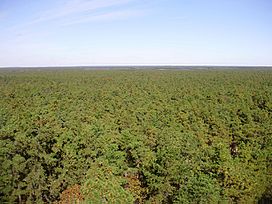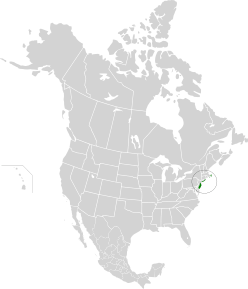Atlantic coastal pine barrens facts for kids
Quick facts for kids Atlantic coastal pine barrens |
|
|---|---|

The Pine Barrens of New Jersey
|
|
 |
|
| Ecology | |
| Realm | Nearctic |
| Biome | temperate coniferous forests |
| Borders | Middle Atlantic coastal forests and Northeastern coastal forests |
| Bird species | 212 |
| Mammal species | 45 |
| Geography | |
| Area | 9,000 km2 (3,500 sq mi) |
| Country | United States |
| States | New Jersey, New York, Massachusetts, Delaware and Maryland |
| Conservation | |
| Habitat loss | 30.06% |
| Protected | 22.9% |
The Atlantic coastal pine barrens is a special kind of forest found along the eastern coast of the United States. It's a temperate coniferous forest, which means it has lots of cone-bearing trees like pines and experiences moderate temperatures. This unique area is known for its sandy, poor soil and how it's shaped by frequent natural fires. These fires help the pine trees grow and keep the forest healthy.
Contents
Where Are the Pine Barrens?
This unique forest used to stretch from North Carolina all the way up to Nova Scotia in Canada. Today, it's found in separate areas. The largest part is the New Jersey Pine Barrens. You can also find smaller parts in southern Long Island in New York State. Another important area is the Massachusetts Coastal Pine Barrens. This stretches from Plymouth, Massachusetts to Cape Cod and the islands of Martha's Vineyard and Nantucket.
The soil in the pine barrens is very sandy and doesn't have many nutrients. This type of soil usually supports shorter, stunted pine forests. The special plants here survive because of the poor soil and the frequent fires. These fires actually help the pines grow back stronger. Areas nearby with better soil have different types of forests.
Climate of the Pine Barrens
The climate in the pine barrens changes depending on where you are. In Delaware, New Jersey, and Long Island, New York, it has a humid subtropical climate. This means it has hot, humid summers and mild winters. In Massachusetts, it has a humid continental climate. This means it has warm to hot summers and cold winters.
Plants of the Pine Barrens (Flora)
The types of plants you see in the pine barrens depend a lot on how often fires happen. Forests with lots of pitch pine trees are common here. But if fires happen very often (every 10 years or less), you'll find dwarf pine forests. These trees don't grow very tall. If fires don't happen often, then oak trees start to take over. In wet areas, you'll find cedar swamp forests and hardwood swamp forests.
Pine Forests
Pitch pine is the most common tree in these forests. You might also see shortleaf pine, but it's not as common. In the southern parts of the New Jersey Pine Barrens, you can find loblolly pine and pond pine. Many types of oak trees grow among the pines. These include black oak, white oak, post oak, chestnut oak, scarlet oak, and blackjack oak. These forests usually have trees spaced far apart, letting lots of sunlight reach the ground.
The ground layer is thick with shrubs. You'll find black huckleberry and early lowbush blueberry. Other shrubs like staggerbrush, dangleberry, mountain laurel, and sheep laurel also grow here. Bracken fern is very common too.
Dwarf Pine Forests
In areas with very frequent fires, only pitch pine and blackjack oak can survive and grow back. Because of the fires, these trees stay small, sometimes only about 4 feet (120 cm) tall. They look more like shrubs than tall trees.
Just like in the pine forests, black huckleberry and early lowbush blueberry are common here. Mountain laurel, sheep laurel, and bearberry also grow well in these dwarf forests.
Oak Forests
When fires don't happen often, dead leaves and branches build up on the forest floor. This makes it easier for oak tree seeds to grow instead of pine seeds. Over time, the old pine trees die, and oak trees take their place. The most common oaks are black, scarlet, chestnut, white, and post oaks. You'll still see some pitch and shortleaf pines mixed in. The tops of the trees in these forests usually form a closed canopy, meaning less sunlight reaches the ground.
The plants growing under the trees are similar to those in the pine forests. Black huckleberry, early lowbush blueberry, and dangleberry are common.
Cedar Swamp Forests
Along the streams and wet areas of the pine barrens, you'll find swamp forests dominated by Atlantic white cedar trees. These white cedars often grow right out of standing water. Unlike the sunny pine forests, these cedar swamps are much darker underneath the trees. You might also see red maple, sour gum, pitch pine, and sweet bay magnolia mixed in. In open spots and along the edges, highbush blueberry, dangleberry, swamp azalea, fetterbush, and leatherleaf grow. Sweet pepperbush, inkberry, and winterberry are also present.
Hardwood Swamp Forests
Sweet gum and red maple are the most common trees in these hardwood swamp forests. American holly, which is an evergreen tree, is also common. Other trees you might find include pin oak, swamp white oak, willow oak, tulip tree, sour gum, and sweet bay magnolia.
Plants like poison ivy and Japanese honeysuckle often grow in thick patches here. Shrubs include arrowwood, spicebush, highbush blueberry, sweet pepperbush, and swamp azalea.
Grasslands
Some parts of the region also have unique coastal grasslands. These are found on Martha's Vineyard, Nantucket, and at the tip of Long Island. An example is the Conscience Point National Wildlife Refuge.
Animals of the Pine Barrens (Fauna)
Many animals have adapted to live in this special environment. Some unique creatures include the Pine Barrens tree frog, the Plymouth red-bellied turtle, and a rare plant called Sabatia kennedyana. The sandy beaches along these coasts are very important breeding grounds for birds like the piping plover. You'll find them especially on Cape Cod, Martha's Vineyard, Nantucket, and Long Island. The roseate tern also breeds here, particularly on Bird Island.
Protecting the Pine Barrens
Sadly, much of the pine barrens ecosystem has been damaged by new buildings and towns. As more people move to the East Coast, especially for vacations or retirement, these natural areas shrink. Only about 10% of the original pine barrens habitat is left, and it's broken up into smaller pieces.
However, there are still large areas that are being protected. These include the New Jersey Pine Barrens, the Long Island Central Pine Barrens in New York, and parts of the Massachusetts Coastal Pine Barrens. Important protected spots in Massachusetts are Myles Standish State Forest, Manuel F. Correllus State Forest on Martha's Vineyard, Cape Cod National Seashore, Joint Base Cape Cod, and lands managed by the Mashpee Wampanoag Tribe. These remaining areas are now well-cared for and conserved.

